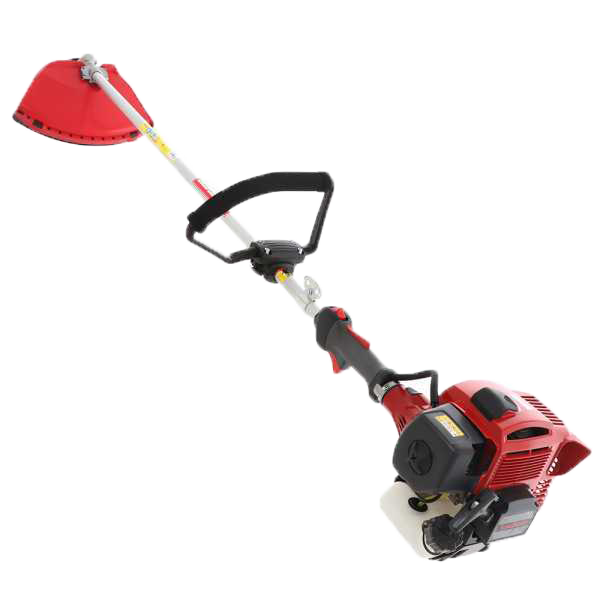A comprehensive guide to purchasing the best petrol powered brush cutter, with many useful tips and lots of information on key features.
The Complete Guide to help you choose the Best Brush Cutter
by the Real Experts of Gardening Machinery
The brush cutter is the main tool commonly used for mowing grass and brushwood of varying diameters. The brush cutter is undoubtedly the most widely used of all garden maintenance tools, due to its versatility in a wide range of applications. But how to choose the best brush cutter? Finding the right product is not easy, but this guide will hopefully provide you with all the information you need.
This purchasing guide will focus on one particular type of gardening equipment: 2/4-stroke brush cutters.
CONTENTS
1. Displacements
The first feature to assess when choosing the best 2/4-stroke brush cutter is certainly the engine. When choosing between different 2/4-stroke brush cutters, it is important to consider not only the power but also, and above all, the engine displacement. Let’s take a few examples: an engine with a displacement of 20 to 30 cc will be suitable for limited use in small gardens, although it will gain in lightness and ease of handling. For medium-intensity work it is better to move towards 31 to 40 cc brush cutters; for heavier work, where you need to mow brambles and tall grass, we recommend choosing engines of 45 cc and above. Depending on the size, displacement and machine level, brush cutters can be divided into:
- 21 – 30 cc small 2/4-stroke brush cutters
- 31 – 40 cc medium 2/4-stroke brush cutters
- 41 – 50 cc large 2/4-stroke brush cutters
- 51 – 60 cc heavy-duty 2/4-stroke brush cutters
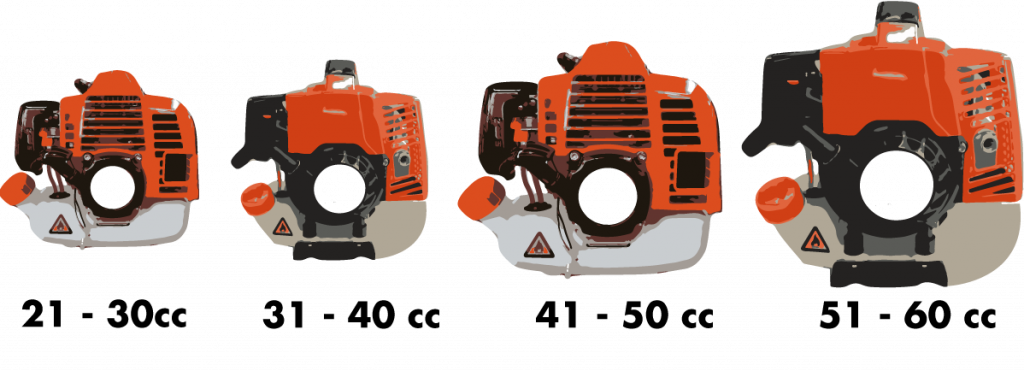
1.1. 21 – 30 cc small 2/4-stroke brush cutters
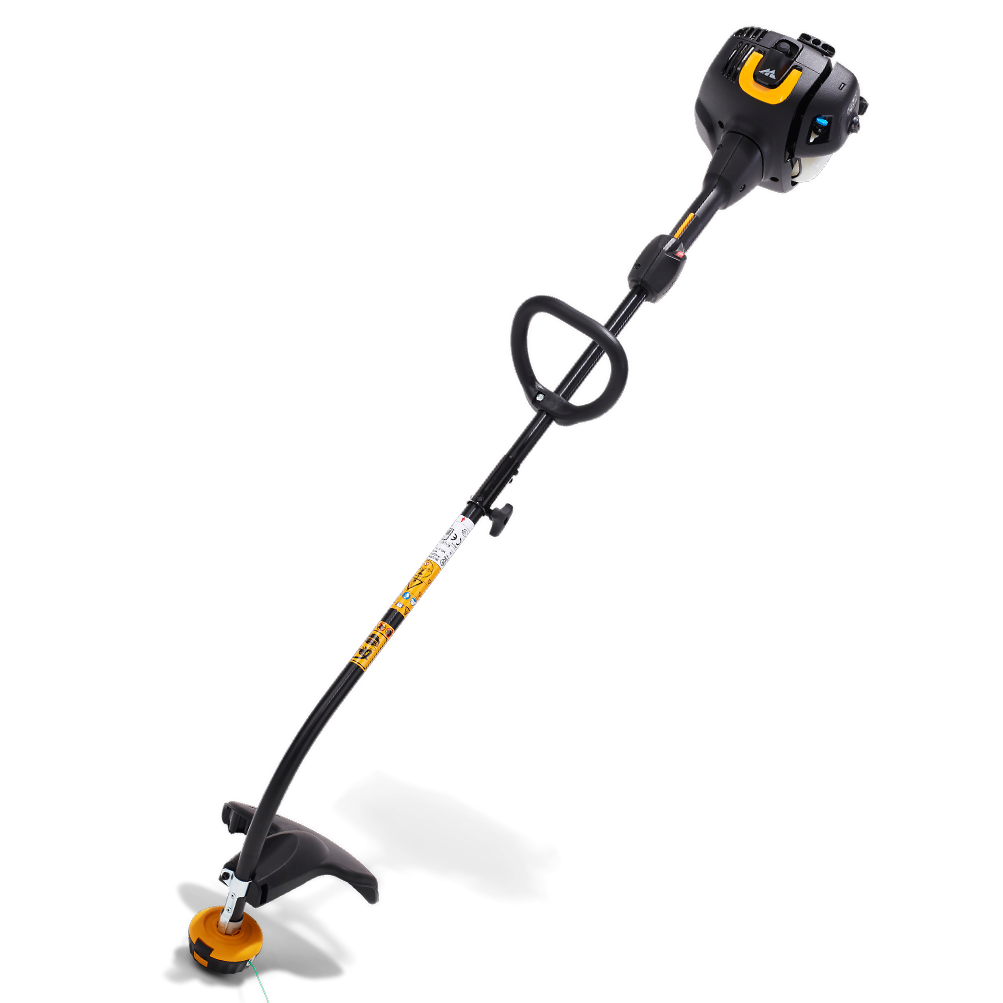
21-30 cc 2/4-stroke brush cutters are the lightest types in their class and therefore they offer an outstanding ease of operation. The main feature of these small brush cutters is their low weight (which does not exceed 6.5 kg) and small size. These features are also particularly appreciated by female users.
These models are fitted with classic 2-stroke engines, characterised by an essential construction design, good bevel gear and good power with a significantly lower weight than the more technological 4-stroke engines. Small 2/4-stroke brush cutters are significantly better performing and more efficient than small electric brush cutters, as they can be used anywhere, without the need to connect to the power supply, as the electric cable can hinder the operator’s movements during work. They are therefore ideal for hobby use and for short, limited work sessions: care and maintenance of small gardens, minor trimming of driveways, edging along walls, pavements, around trees and bushes.
1.2. 31 – 40 cc medium 2/4-stroke brush cutters
Medium 2/4-stroke brush cutters have displacements of up to 40 cc. These are classic brush cutters designed for universal use and are the most versatile to work in all conditions. They are intended for the private user who is looking for a powerful, yet practical and lightweight product.
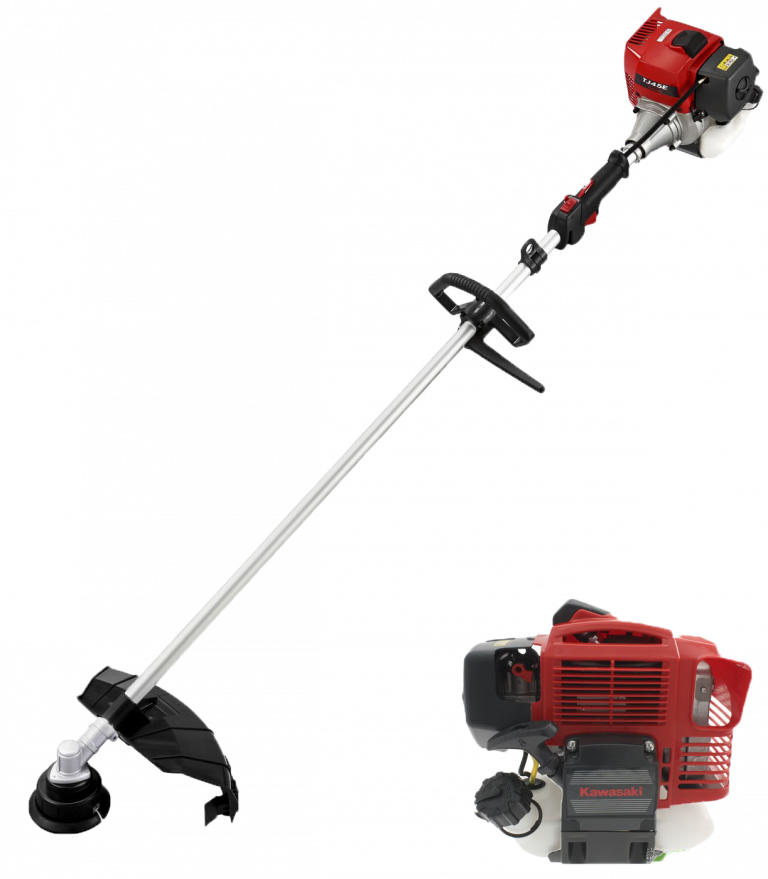
These brush cutters are the most sought-after and best-selling in their class. The reason for this lies in the fact that they are essentially a sort of middle ground models, i.e. suitable for hobby-range work but also powerful enough to withstand occasional heavy-duty work sessions. These are fitted with classic 2-stroke engines featuring all the benefits mentioned above. The main features of these brush cutters can therefore be summarised as follows:
- Good power
- Versatility
- Maneuverability
- Low weight
In this range we find models with very different pricings: on the one hand there are more cost-effective brush cutters together with other imported products, on the other hand there are heavy-duty-range models manufactured in Japan or Europe by renowned brands. Among the main ones are Kawasaki, Blue Bird, HIKOKI etc…
They feature highly reliable motors, great performance and a robust transmission shaft with a diameter of around 26 mm.
1.3. 41 – 50 cc large 2/4-stroke brush cutters
When it comes to large 2/4-stroke brush cutters, we mean machines primarily intended for green maintenance professionals. Obviously, given the versatility of these machines, even the most demanding private users can choose brush cutters with a displacement of around 50 cc.
Thanks to their powerful engines, these 2/4-stroke brush cutters are ideal for mowing tall, dense grass, for clearing brush and brambles, bushes and weeds.
As far as garden care is concerned, brush cutters with 40-50 cc 2-stroke engines are operated on medium to large lawn areas and guarantee fast and efficient work.
Also in this category there is a wide variety of models: from more affordable ones to the most professional. Among the heavy-duty ones there are models branded Kawasaki, Blue Bird, HiKOKI etc.
These are definitely the ones best suited to heavy-duty and extended work sessions. They are equipped with high-performance 2-stroke engines and robust transmission shafts that support such power. The models with the best value for money, sometimes imported, come with a very good level of quality and excellent performance.
1.4. 51 – 60 cc heavy-duty 2/4-stroke brush cutters
Heavy-duty 2/4-stroke brush cutters represent the top of the range and are designed for professional gardeners for efficient and fast mowing of tall grass. Because of their large size, they are often available with a bullhorn handlebar. Many are equipped with the oversized clutch bell connector that links the engine to the double handlebar.
The best petrol brush cutter will combine great power, great reliability and a high level of user comfort, which is necessary to reduce workload and stress for the user during prolonged work sessions. These brush cutters will therefore be equipped with efficient anti-vibration systems and professional harness to support the weight of the machine. They can be used in both gardening and forestry, suitable for clearing brush, brambles and shrubs.
These machines mount the best 2-stoke engines with displacements of up to 60 cc. Some of the most interesting features of these brush cutters include:
- Machine sturdiness
- Larger and more effective anti-vibration system
- Greater working comfort for the operator whose side touches a larger part of the machine (the other models have a smaller contact surface, which corresponds only to the transmission shaft)
1.5. 4-stroke petrol brush cutters
4-stroke brush cutters are usually medium-power machines, less powerful than 2 strokes. They are intended for the private user looking for comfort and ease of use, whereas 2-stroke brush cutters are always professionals’ first choice.
The 4-stroke is a mechanically more complex engine than 2-stroke ones, nevertheless resulting in a lower durability over time.
2/4-stroke brush cutters are also heavier than fuel-oil mix ones. Of course, despite their constructive complexity, with technological innovation their weight has considerably reduced, approaching the weight of the 2-stroke, although not reaching it.
The 4-stroke engine has its own advantages over the 2-stroke engine, which will be discussed in detail in the next section. Displacements can range from 25 to 50 cc.
The best 4-stroke petrol brush cutter features HONDA engines series: GX25, GX35 etc.
This year the new HONDA GX50 4-stroke engine was introduced to the market: a high-powered petrol engine that is approaching the 2-stroke market, even though, in large displacements, fuel-oil mix engines retain the best performance and are still the most widespread.

2. 2-stroke engine VS 4-stroke engine
2-stroke or 4-stroke engine Brush cutters? Both types have pros and cons, although in the brush cutter market the vast majority of users have always preferred the 2-stroke. The choice of engine depends mainly on the intended use and work requirements.
2.1. Brush cutters with 2-stroke engine
These engine types are fitted to the vast majority of brush cutters. They are undoubtedly the most common and most sought-after engine solution for users. But why are 2-stroke engines so popular in brush cutters? What are their real benefits?
- Higher power for the same displacement compared to 4-stroke engine
- Greater suitability to professional use
- Higher torque than 4-stroke engines
- Low weight and easy handling
- Constructive simplicity
- Easier maintenance *
*In this respect, we suggest you to consult our Guide to 2-Stroke Engine Maintenance, for more information about the technical features of this type of engine.

On the other hand, it should be said that there are also disadvantages to 2-stroke engines:
- First of all, the fuel-oil mix must be prepared
- Higher specific consumption
- More vibrations
- Higher emissions and more smoke, which can be an obstacle to the user’s work
- Higher noise levels as the engine has higher revs.
2.2. Brush cutters with 4-stroke engine
The 4-stroke engine is technically more complex than the 2-stroke: its cycle is developed in two crankshaft rotations and takes place in four stages.
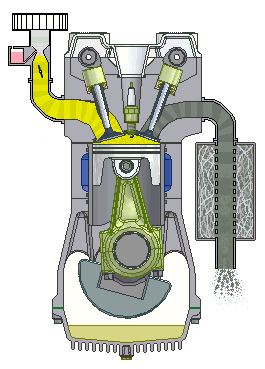
- intake
- compression
- combustion
- exhaust
Despite the greater complexity of construction and operation, it still has certain advantages:
- High fuel efficiency
- Lower fuel consumption for the same displacement compared to 2-strokes
- Reduced harmful emissions
- Lower noise levels
- Less vibrations
We must underline, however, that the 4-stroke engine has a less “rapid” operation than 2-stroke ones.
- Lower power
- Increased weight
- Less durability than 2-strokes
CONCLUSIONS:
For professional use, a 2-stroke brush cutter is a good choice, as it offers higher performance, less mechanical complexity and a longer service life.
Private users looking for comfort and ease of use might prefer a 4-stroke model.
| Features: | 2-stroke | 4-stroke |
|---|---|---|
| More power | ✔ | ❌ |
| Higher torque | ✔ | ❌ |
| Lower weight | ✔ | ❌ |
| Long-term durability | ✔ | ❌ |
| Less vibrations | ❌ | ✔ |
| Less smoke | ❌ | ✔ |
| Lower noise levels | ❌ | ✔ |
| Easy start-up | ❌ | ✔ |
| Ease of use | ❌ | ✔ |
| Fuel simplicity | ❌ | ✔ |
3. The grips
The best petrol brush cutter should not only be powerful, but also, and above all, be practical to use. This is why the presence of ergonomic handles, straps and of course, the weight of the brush cutter itself represent an key feature. But why are these features so important when choosing the best brush cutter?
The brush cutter produces strong vibrations that spread from the engine and cutting unit all along the shaft. The machine therefore has a conditioned level of comfort and it is precisely in these cases that the different types of ergonomically designed and shock-absorbent grips come into play.
3.1. The single loop handle
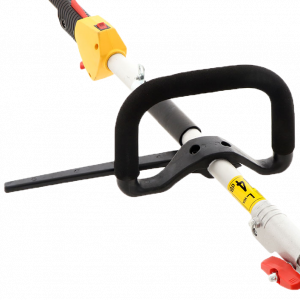
The single loop handle is the most common type. It is mounted in the lightest brush cutters, which therefore also have a smaller engine and a less robust, smaller-diameter transmission shaft.
Usually, the operator’s left hand grips the single loop handle while the right hand holds the one with the brush cutter controls: throttle, start switch, stop switch and safety.
But what is the great benefit of this type of handle?
ITS VERSATILITY
The single handle provides the highest degree of versatility.
Thanks to their low weight, single loop handle brush cutters can also be used for clearing banks. The machine can be operated in various positions, including vertically by attaching the pruner or hedge trimmer attachment.

3.2. The bullhorn handlebar
The double handle, also known as bullhorn handlebar, is usually found on larger brush cutters. It consists of a more ergonomic handle generally fitted to more expensive brush cutters.
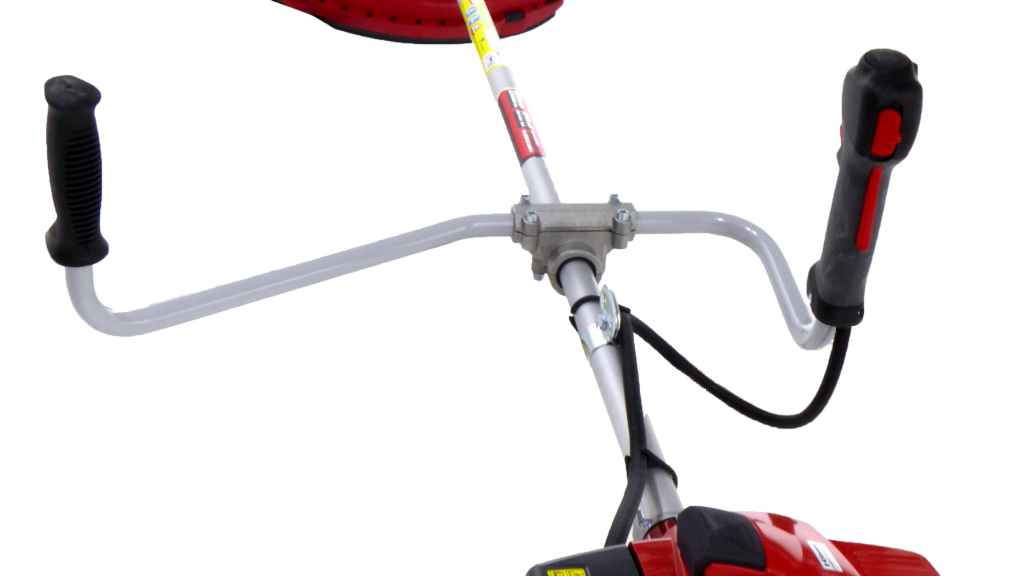
This handle makes users work in an upright position, making them less tired and improving their posture. The bullhorn handlebar proves to be especially useful for longer working sessions and for mowing of tall grass in flat areas.
These qualities of course come at the expense of lower versatility compared to the single loop handle.
The bullhorn handlebar is the direct evolution of the sickle, the movement that the user has to perform is practically the same, but obviously with a much lower level of fatigue.
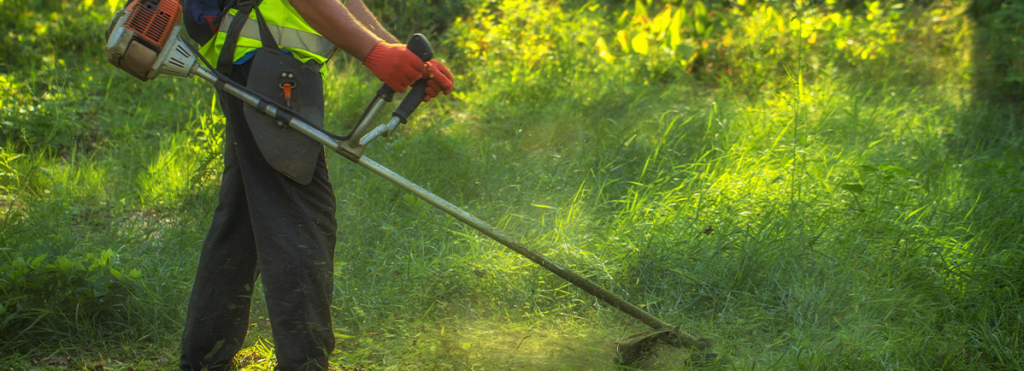
In terms of ergonomics and effectiveness against brush cutter vibrations, these are qualitatively superior to the classic single loop handle.
4. The harnesses
4.1. The single and double shoulder strap harness
Harnesses for a brush cutter can be of two types:


The double shoulder strap harness is definitely better than the single one, as it distributes the weight of the brush cutter over both shoulders and hips.
The single loop handle of the brush cutter can be combined with both types of shoulder strap harness. The bullhorn handlebar, on the other hand, necessarily requires a double shoulder strap harness.
In the bullhorn handlebar, the weight of the brush cutter is borne by the two arms and the back, the operator’s hands do not exert any holding force, as it is mainly the back that carries all the weight (the operator is closer to the engine). In the single loop one, however, it is only the arms that hold the weight.
4.2. The backpack brush cutter
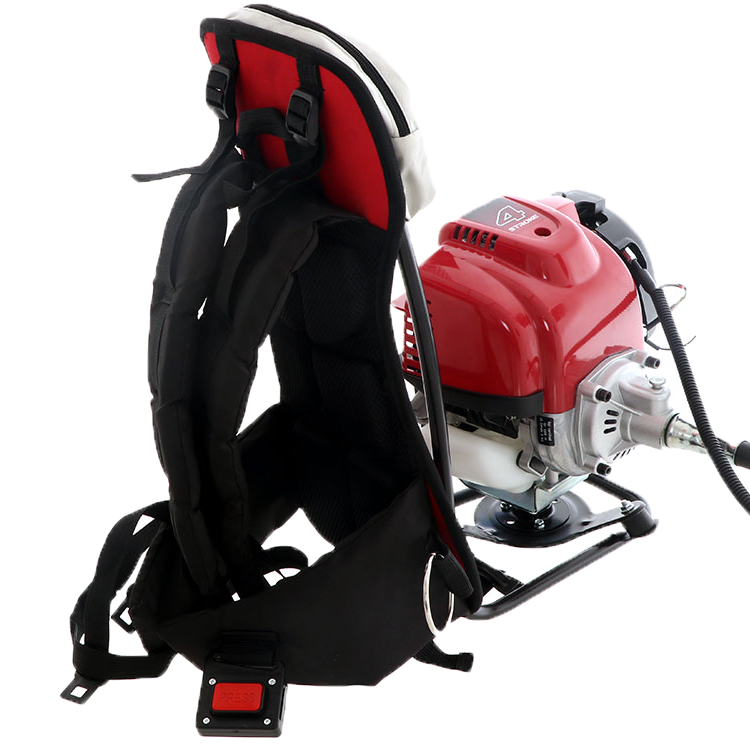
The choice of a 2/4-stroke backpack brush cutter depends essentially on personal taste. However, there are some basic features that are worth knowing about. First of all, a backpack brush cutter generally weighs 3 kg more than a standard model. But it certainly feature some ADVANTAGES, as the weight of the tool will no longer be on the user’s arms, but it will be shifted to the shoulders, thus making the work more comfortable.
A backpack brush cutter allows the 2/4-stroke engine to be positioned and secured on the back; although this turns out to be convenient in terms of weight reduction, the user will still have to get used to the “restraint” of the harness.
The backpack solution is recommended for brush cutters with a high weight and therefore a powerful engine. It would be completely useless on light, hobby-use, low-displacement brush cutters.
5. The transmission
5.1. Shaft type
The transmission is an essential part of the brush cutter. The robustness and solidity of the machine largely depend on it. A first distinction should be made between:

- straight shaft
- curved shaft
The straight shaft requires the presence of a bevel gear and therefore a right angle gear reducer. This serves to gear down the engine revolutions: less revs and more power (a 2-stroke engine can reach up to 10,000 rpm).
The curved shaft is found on more affordable brush cutters (or on small electric edge strimmers). This type of transmission shaft is of a lower quality since it does not include the bevel gear and the right angle gear reducer.
Straight rods can come in three different types depending on their diameter (they will however have the same length). The more powerful an engine is, the larger the diameter of the transmission shaft, which allows it to better deaden the stresses and vibrations produced by the engine. But what are the diameters of the rods that are conventionally found on the market?
- Lightweight shaft (with a diameter of 24 mm, can be found on hobby brush cutter models)
- Medium shaft (with a diameter of 26 mm, is fitted to medium-powered brush cutters for heavy-duty private use)
- Professional shaft* (28 mm of diameter, also ideal for heavy-duty brush cutters)
*in rare cases, 30 mm shafts can also be found. The big difference lies is the manufacturing brand of the shaft, therefore an Italian or European production transmission shaft will have a completely different quality than a Chinese one.
5.2. The drive spindles
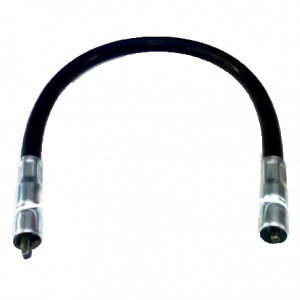
Drive spindles can be rigid, in the case of average brush cutters, and flexible, as in the case of brush cutters with curved shafts. In backpack brush cutters the spindle will be rigid + flexible.
However, the flexible drive spindle (casing) of the knapsack brush cutter is of a much higher quality than the flexible spindles found on cost-effective, curved shaft brush cutters.
A flexible transmission consists of a rigid shaft plus a flexible that connects the shaft to the engine.
It is important to assess the various shapes of the transmission shafts and bushings that determine whether the brush cutter can be fitted with various accessories such as a pruner or hedge trimmer.

- A: 7 spline bushing
- B: 9 spline bushing
- C: 10 spline bushing
- Q: 5.4 mm square bushing
- E: 6 mm square bushing
- F: 5.5 mm elliptical bushing
- G: 6.5 mm elliptical bushing
5.3. Brush cutters with different engine brand
Brush cutters with a different engine brand are a particular type of gardening equipment whose engine and shaft are made by two different manufacturers. The engine is usually produced by well-known Japanese brands. These are the most important engines on the brush cutter market: Kawasaki and Honda.
People often make the mistake of confusing the brand name of the entire brush cutter with the brand name of its engine, but this is not the case! The engine accounts for 50% of the brush cutter, so the other 50% (shaft + bevel gear) is also very important. Buying a brush cutter with a powerful engine but a second-rate transmission shaft is a serious but unfortunately frequent mistake.
The reason for this is that a low quality shaft – usually the large number of Chinese-imported shafts on the market – is not able to withstand the impact of a powerful engine like those by Kawasaki or Honda. The shaft can easily break, leaving the user with a top-quality engine, but with the burden of having to buy another brush cutter.
The combination of high quality motor + low efficiency shaft is not a practical solution . Therefore, when dealing with brush cutters with very powerful engines, you must also pay close attention to the quality, geographical origin and therefore the manufacturer of the transmission shaft!
6. The bevel gear
The bevel gear of a brush cutter is the final part of the shaft; it has the function to transmit the motion to the cutting unit.
The size of the bevel gear is an indication of its quality, so the larger a bevel gear is, the more valuable and robust the tool will be. But size goes along with another characteristic, namely the origin of the bevel gear: indeed, bevel gears made in Italy, Germany and Japan are far superior in quality to those made in China.
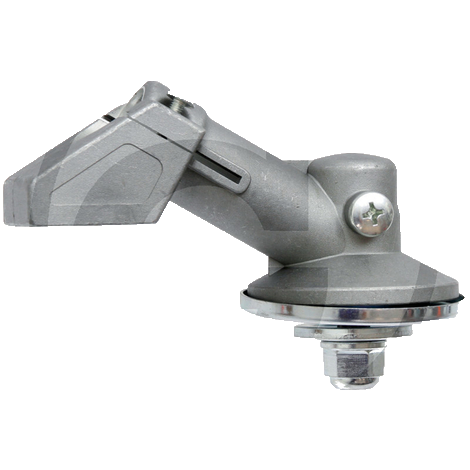
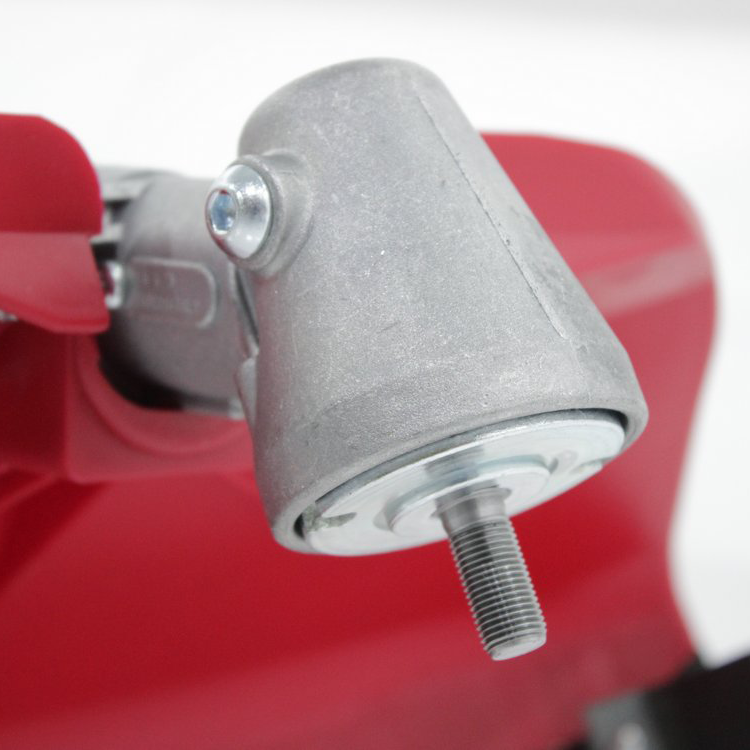
7. The cutting unit: line or blade?
The brush cutter is a versatile and flexible tool. This versatility is also supported by the various cutting devices that can be applied to the shaft. The most frequently used is undoubtedly the nylon strimmer line, but for harder work the blade or disc may be required.
The different cutting unit can be easily replaced by removing and fitting the brush cutter head in just a few minutes.
7.1. The line head
The line head is used for cutting grass that is not excessively tall and thick. Cutting is quick and not very dangerous, although it is always necessary to wear the usual protections.
The head contains a rock of nylon strimmer line with its two ends sticking out. When the head, operated by the engine, starts to rotate, the two ends of the line stiffen and, thanks to their fast rotating motion, are able to cut the grass. This type of cutting is less effective with brambles or shrubs, because when the line meets an obstacle that is too hard, it breaks.

The line can have different diameters, chosen according to the grass mowing job to be done. The most common is the 2/3 mm nylon trimmer line. But the shapes of the line can be different:
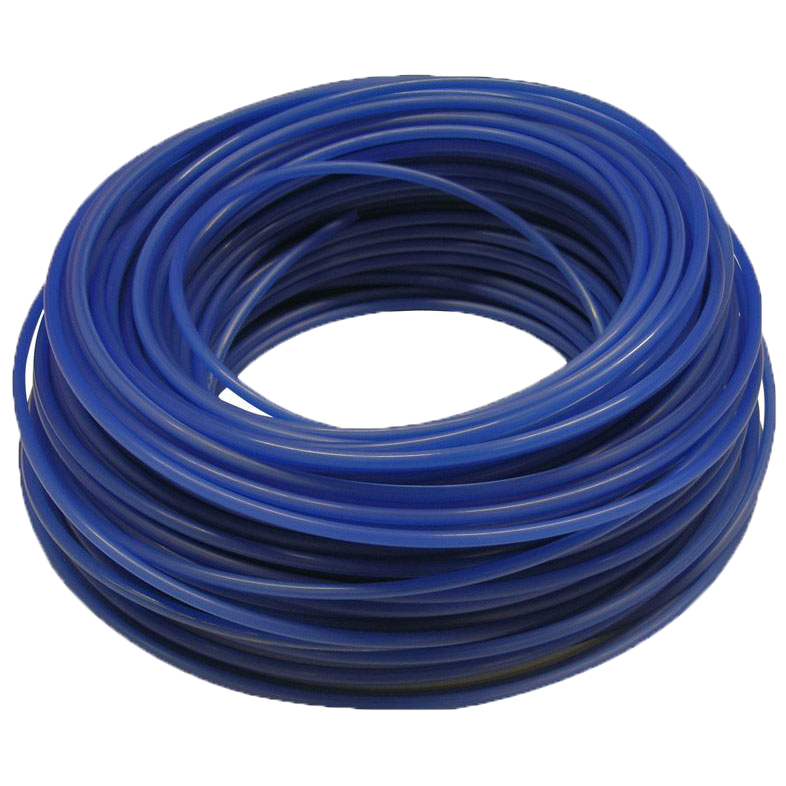
Classic rounded strimmer line roll

Squared strimmer line roll
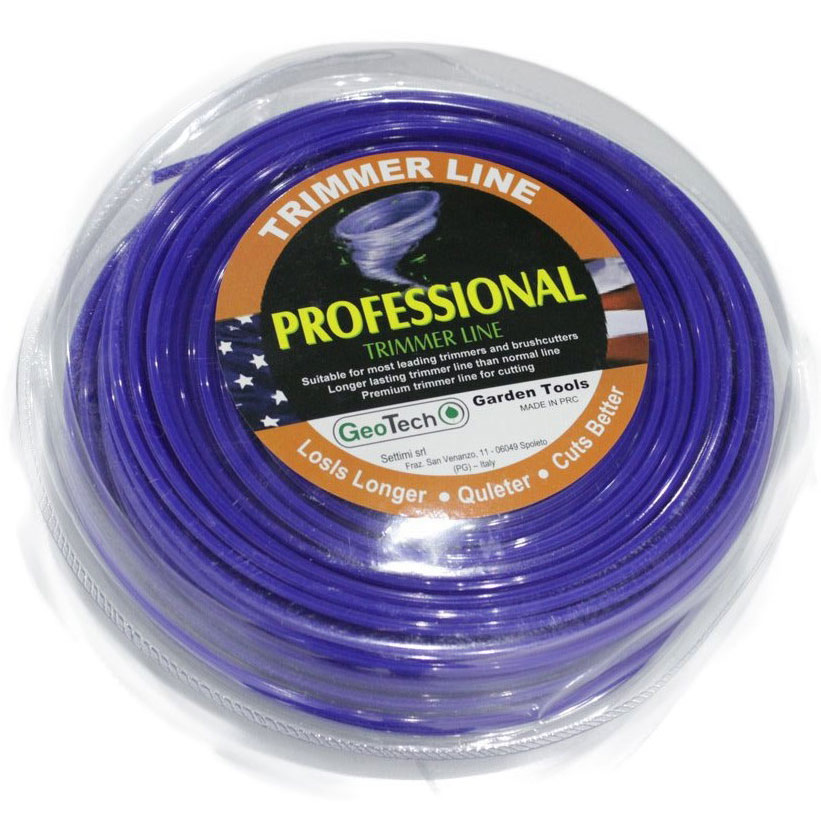
Hexagonal strimmer line roll
The classic rounded line is more practical than other types because it jams less frequently and is less subject to breakage compared to other types for the same diameter.

As far as heads are concerned, there are different models. Those with fixed line ends have now been outcompeted by the more practical “tap and go” heads. These allow the cutting line to be extended without stopping the brush cutter during operation: you simply need to tap the brush cutter’s under cup on the ground while working.
7.2. The blade or disc head
The blade or disc is used for those cutting operations where the line cannot perform the job properly. Generally, all situations where the grass is very thick or tall, or small brambles or shrubs need mowing. The 3-tooth disc is the most commonly used. It is made of very high-strength hardened steel and generally has a diameter of 255 mm. The 3 teeth are very sharp in the side corresponding to the direction of rotation.

7.3. Tungsten disc
The tungsten disc, also called WIDIA disc, is suitable for clearing trees, cutting bushes, brambles, broom, etc., and for all jobs where a high cutting force is required.
It is equipped with 40 extremely sharp teeth and generally has a diameter of 255 mm.

8. Safety systems
Last, but certainly not least, a mention should be made about the protective clothing to wear when using a brush cutter. These include:
- Helmet with visor
- Noise cancelling ear muffs
- Anti-cut protection work jacket and trousers
- Protective gloves
- Safety shoes or protection work boots






